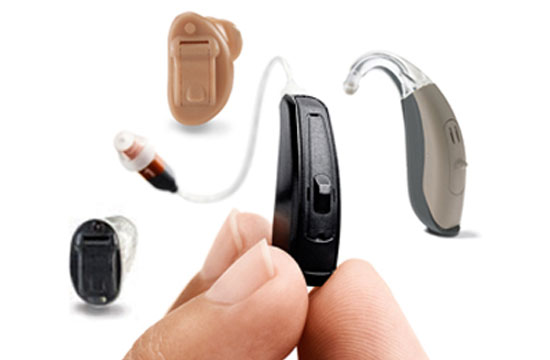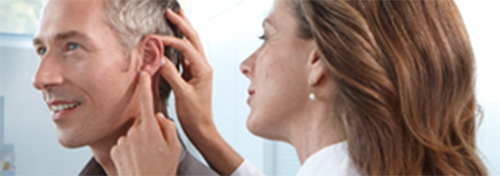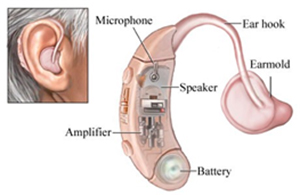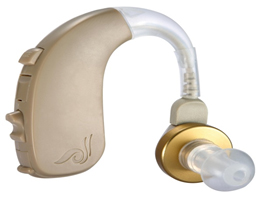
Your audiologist will ask you what difficulties you may be having with your hearing and discuss what options are available to assist you.
Hearing Aid Specialists Ltd has access to over 300 different models of hearing aids and careful consideration is needed to select hearing aids which will be best for your hearing needs and budget.
Once suitable hearing aids have been selected your Audiologist will arrange for them to be ordered. This usually takes between one to three weeks. It may require an impression of your ear to be taken so that the hearing aids or ear moulds will fit your ears comfortably.
Your audiologist will fit your hearing aids in a soundproof room. They will make sure that the hearing aids fit comfortably in your ears and then check that the hearing aids are working appropriately for your hearing loss. Your audiologist will talk to you about what to expect from and how to look after your hearing aids.
During the trial period (usually one month) your audiologist will see you on several separate occasions to ensure that you are getting the best performance out of your hearing aids. At each follow up appointment changes can be made to how the hearing aids are working if required and sometimes a different style of hearing aid may be needed. Because the hearing aids are initially fitted in a soundproof room, using the hearing aids in the “real world” situations that you are experiencing difficulty with is the only way of really knowing how well your hearing aids are performing.
To benefit from hearing aids you need to use them as much as possible. You will hear sounds that you may not have heard for many years and so things may initially sound quite different to what you are used to. Your hearing system need time to adjust to the new sounds you are hearing.
To ensure you get the most benefit from your hearing aids the Hearing Aid Specialists Ltd has a free trial period of usually one month. You will need to pay for the hearing aids at the end of the trial however, if you decide to return the hearing aids within the trial period then there is no cost. All follow up appointments are included in the cost of your hearing aids for a period of one year.
This section will take you through the process of getting a hearing aid fitted, hopefully answering any questions you may have. Of course, you will have the opportunity to ask questions when you come in for your fitting, too, but this section can help you feel prepared.
As a guide, non-customised hearing aids are usually fitted within one week and custom hearing aids are fitted within two weeks of your hearing assessment. Before your fitting we will have selected and programmed your hearing aid so that it meets your specific needs.
Please allow at least an hour for your appointment, but be aware that appointment lengths may vary.
Before your fitting, please ensure your ears are free from earwax build-up as this may make it impossible for us to fit your hearing aid. If you will require an interpreter - including sign language - at your appointment, please let us know at your assessment appointment.
First of all, the audiologist will check that your ears are free of wax build-up. Next he or she will make sure your hearing aid system fits correctly, checking its position for comfort and security and making any adjustments which may be necessary.
The audiologist will have fitted a battery into your hearing aid. While your hearing aid will have been specially programmed for your needs before your appointment, the audiologist may need to fine-tune it at this point.
 During your appointment you will learn how to put your hearing aid in and take it out, as well as how to switch it on and off. It's a good idea to practise these steps several times before you leave your appointment. The audiologist will also show you how to fit a new battery, how to clean the hearing aid and how to store it when it's not in use. You can also find tips on these areas of maintenance on our website: read about replacing hearing aid batteries and cleaning a hearing aid.
During your appointment you will learn how to put your hearing aid in and take it out, as well as how to switch it on and off. It's a good idea to practise these steps several times before you leave your appointment. The audiologist will also show you how to fit a new battery, how to clean the hearing aid and how to store it when it's not in use. You can also find tips on these areas of maintenance on our website: read about replacing hearing aid batteries and cleaning a hearing aid.
If you are worried about remembering all this new information, rest assured that you will be given a manual for your hearing aid which you can use to remind yourself of any information the audiologist gives you at your appointment. Also, you are more than welcome to note things down or bring a friend or relative along with you.
Since you won't be used to your new level of hearing, it's best not to wear your hearing aid to go home straight after your appointment. Instead, we advise that you give yourself time to adjust to it in the comfort of your own home, and wear it to go out when you are a little more familiar with your new hearing abilities.
In the month or two following your hearing aid fitting, it's normal to come back to the centre for any necessary additional testing and to allow us to address any questions or concerns you may have.


Hearing aids are sound-amplifying devices designed to aid people who have a hearing impairment.
Most hearing aids share several similar electronic components, including a microphone that picks up sound; amplifier circuitry that makes the sound louder; a miniature loudspeaker (receiver) that delivers the amplified sound into the ear canal; and batteries that power the electronic parts.
Hearing aids differ by:
Some hearing aids also have earmolds or earpieces to direct the flow of sound into the ear and enhance sound quality. The selection of hearing aids is based on the type and severity of hearing loss, listening needs, and lifestyle.
Analog hearing aids make continuous sound waves louder. These hearing aids essentially amplify all sounds (e.g., speech and noise) in the same way. Some analog hearing aids are programmable. They have a microchip which allows the aid to have settings programmed for different listening environments, such as in a quiet place, like at a library, or in a noisy place like in a restaurant, or in a large area like a soccer field. The analog programmable hearing aids can store multiple programs for the various environments.
As the listening environment changes, hearing aid settings may be changed by pushing a button on the hearing aid. Analog hearing aids are becoming less and less common.
Digital hearing aids have all the features of analog programmable aids, but they convert sound waves into digital signals and produce an exact duplication of sound. Computer chips in digital hearing aids analyze speech and other environmental sounds. The digital hearing aids allow for more complex processing of sound during the amplification process which may improve their performance in certain situations (for example, background noise and whistle reduction). They also have greater flexibility in hearing aid programming so that the sound they transmit can be matched to the needs for a specific pattern of hearing loss. Digital hearing aids also provide multiple program memories. Most individuals who seek hearing help are offered a choice of only digital technology these days.
If you have a hearing aid that isn't working correctly or needs repair, don't throw it away or leave it sitting in a drawer!
Many times, these old or broken hearing aids only need a small repair or reprogramming and they'll work as good as new. Bring it into any Hearing Lab locations and one of our hearing specialists will examine your hearing instrument completely FREE.
Most hearing aid repairs can be done inour office for no charge. These types of repairs include: fixing battery doors, tubing, minor reprogramming of many types of instruments, ear bud replacement, extensive deep cleaning and minor patching. You shouldn't let small problems like these impede your hearing or force you to spend hundreds or even thousands on a new instrument. Take advantage of our service and expertise and bring in your hearing aid now.
Other more extensive hearing aid repairs can be done for a small charge. Typically, Hearing Lab only charge a manufacturer's fee to fix an instrument. These hearing aid repairs include recircuitry, fixing holes or split hearing instrument, corrosion, repair or addition of extraction cord, and much more.
Hearing Lab can repair and service most hearing aids including:
Self programming your hearing aid
Have you ever thought of programming your own digital hearing aids? It is very doable if you have the will and are not afraid of trying new things. There are several advantages of doing it yourself instead of going to an audiologist:
Self-programming a hearing aid is not difficult; however you have to know what you are doing and have the right tools. Over-amplification is the biggest concern; always use the lowest possible gain for a given environment. Prolong exposure to loud noises can further damage your hearing. Beware. Also get advice from your doctor to make sure that hearing aid is the solution to your hearing loss.
Follow the steps below to begin your journey to program your hearing aids.
Without the software, you still can do this by trial and error if your hearing aid does not require any special tools to make adjustments. Listen to tunes of various frequencies (50hz to 15khz) and make adjustments until you find a setting that is best for you. This is essentially what the software is trying to do. Some hearing aids come with programming software and hardware. You can just use them; otherwise, you will need to build your own system, which can be difficult unless you know someone in the hearing professional field. We will cover this in the next article Tools for Hearing Aid Programming.
The most important issues in determining which hearing aid is right for you are the results of your hearing test, your lifestyle, the style of hearing aid that you prefer and your level of dexterity. Based on these four key factors, your hearing aid audiologist will recommend the hearing aids that are most appropriate for you to ensure that they will satisfy your individual needs and that you will feel comfortable and confident wearing them every day.
There are three main types of hearing aid each with their own fitting styles. Your hearing aid audiologist will help you choose the type that is right for you.
1. B.T.E.
2. R.I.C
3. CIC
4. ITE
5. L.I.C